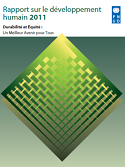HDR 2011
HDR 2011
January 21, 2012
Development progress in the world’s poorest countries could be halted or even reversed by mid-century unless bold steps are taken now to slow climate change, prevent further environmental damage, and reduce deep inequalities within and among nations, according to projections in the 2011 Human Development Report.
Sustainability and Equity: A Better Future for All argues that environmental sustainability can be most fairly and effectively achieved by addressing health, education, income, and gender disparities together with the need for global action on energy production and ecosystem protection.
International Human Development Indicators
The human development data utilized in the preparation of the Human Development Index (HDI) and other composite indices featured in the Human Development Report are provided by a variety of public international sources and represent the best and most current statistics available for those indicators at the time of the preparation of this annual report. Calculations of HDI values and country rankings are the sole responsibility of the Human Development Report Office. The 2011 Human Development Report, an editorially independent publication commissioned by the United Nations Development Programme, was published in print and on line on November 2nd, 2011. Read more
Data Tools and Visualizations
- Country Profiles
Find the latest statistics for all UN member-states
- Public Data Explorer
Our data, easy to explore, visualize and communicate
- StatPlanet World Map
Chart human development statistics for all nations
- Human Development Index Trends
Regional and national trends for 1980-2011
- HDI rankings adjusted for inequality
An HDI calculus reflecting internal inequalities
- GDP vs. HDI: Country contrasts
National HDI compared to income (GNI per capita)
- DIY HDI: Build Your Own Index
Create unique country comparisons and rankings
- Human Development Indicators
Explore development data over the past 30 years
- Country Profiles
Human Development Index (HDI) - 2011 Rankings
Document Highlights
- Reproductive rights can further reduce environmental pressures by slowing global demographic growth, with the world population now projected to rise from 7 billion today to 9.3 billion within 40 years.
- Some 120 national constitutions guarantee environmental protections, but in many countries there is little enforcement of these provisions, the Report says.
- India's Rural Employment Guarantee Act cost about 0.5 percent of GDP in 2009 and benefited 45 million households—one-tenth of the labour force; Brazil’s Bolsa Familia and Mexico’s Oportunidades programmes cost about 0.4 percent of GDP and provide safety nets for about one-fifth of their populations.

 Locations
Locations





